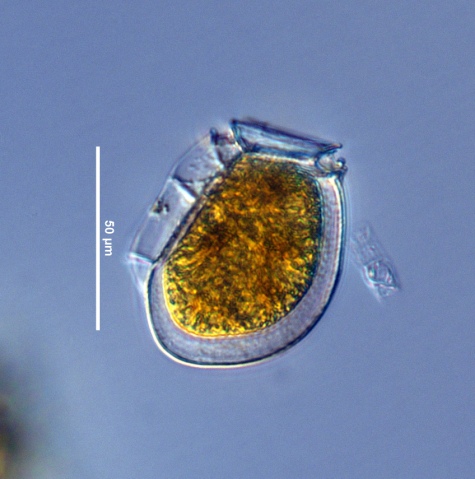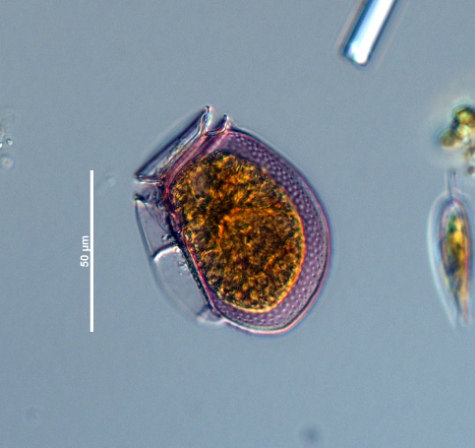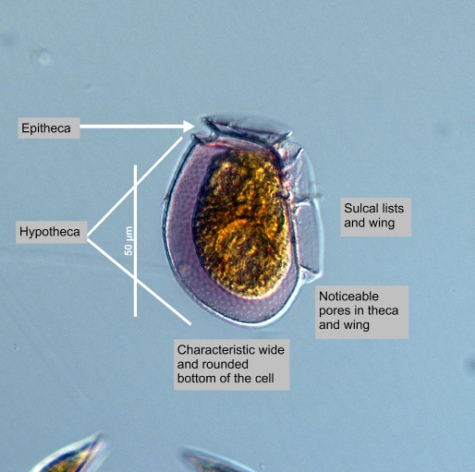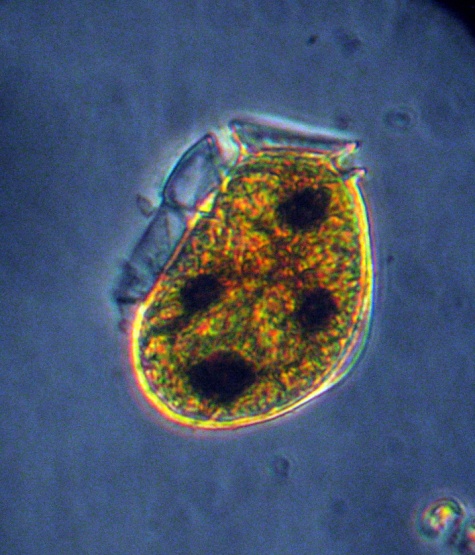




|
Synonym(s)
Dinophysis laevis (Bergh 1881) Pouchet 1883
Dinophysis ovum Schutt 1895 sensu Martin 1929
(Moestrup and Brandt 2011)
Classification
(Guiry and Guiry 2011)
Lifestyle
Binary fission
A form of asexual reproduction where one cell divides into two identical cells. All prokaryotes and some eukaryotes reproduce in this manner. Compare with mitosis, where the nucleus must also divide, adding an extra step to the process.
binary fission (Montagnes 2006, Smithsonian 2012).Description
Ovoid
Oval or egg-shaped.
subovoid and widest ClosePosterior
The back end of a cell. Opposite of anterior.
posteriorly. Cells have a curved CloseDorsal
Relating to the back portion of the cell; opposite to the ventral side.
dorsal CloseMargin
The outline or border that defines the shape of an organism or cell.
margin and an almost straight CloseVentral
Relating to the underside of an organism; abdominal.
ventral margin. The cell surface has deep ClosePoroid
A simple hole through the surface of a diatom valve (Smithsonian 2011).
poroids (Tomas 1896). Cells also have two well-developed CloseSulcal list (left and right)
In dinokont dinoflagellates, a well-defined groove on the ventral surface that is supported by ribs.
sulcal lists. The left sulcal list is about ⅘ of the cell length. The right sulcal list is also long and can extend beyond the second CloseRibs
Features that provide support to other structures in the cell.
rib (Horner 2002). Dinophysis fortii has a wide rounded posterior and CloseReticulated
Resembling a net or having a pattern that resembles a net.
reticulation on the sulcal lists. D. fortii cells have many large centrally placed chloroplasts (Smithsonian 2012).Measurements
Width: 41 - 58 μm
Similar species
Hypotheca
In thecate dinoflagellates, the posterior part of a dinokont cell above the cingulum. The equivalent of a hypocone for naked dinoflagellates.
hypotheca have an almost straight edge, meaning that they meet at acute angle and form a fairly sharp tip. The hypotheca of Dinophysis acuminata has round or oval-shaped sides, unlike the straight sides of Dinophysis acuta. Both D. fortii and D. acuminata have round or oval-shaped hypothecas, but D. fortii has a bulging side.Harmful effects
Lipophilic
Having the ability to combine with or dissolve lipids.
lipophilic toxins (okadaic acid derivatives and pectenotoxins) causing diarrhetic shellfish poisoning (DSP; Hoshial et al. 2003). D. fortii may be toxic because it eats toxic ClosePicoplankton
Phytoplankton within the size range of 0.2 to 2 μm which may be autotrophic, heterotrophic or mixotrophic. They are often found in oligotrophic regions because of their high surface-area-to-volume ratio that better enables them to make use of limited nutrients available (Callieri and Stockner 2002).
picoplankton species, but not because it produces the toxins itself (EOL 2011). This species was the first species to have been associated with DSP. Cell concentrations as low as 200 cells L-1 can harm humans (Smithsonian 2012).Habitat
Distribution
Growth conditions
Environmental Ranges
Temperature range (°C): 6.776 - 28.275
Nitrate (μmol L-1): 0.179 - 9.600
Salinity: 31.144 - 39.081
Oxygen (mL L-1): 4.512 - 7.455
Phosphate (μmol L-1): 0.090 - 1.452
Close
Silicic acid
A general term to describe chemical compounds containing silicon, oxygen and hydrogen with a general formula of [SiOx(OH)4-2x]n. Diatoms polymerize silicic acid into biogenic silica to form their frustules (Azam and Chisholm 1976).
Silicate (μmol L-1): 0.754 - 19.032(EOL 2011)
Bloom characteristics
References
Encyclopedia of Life (EOL). 2011. Dinophysis fortii Pavillard. http://www.eol.org. Accessed 09 Sept 2011.
Guiry, M. D. and Guiry, G. M. 2011. Dinophysis fortii Pavillard. http://www.algaebase.org pages 782802. Accessed on 18 July 2011.
Horner, R. A. 2002. A Taxonomic Guide To Some Common Phytoplankton. Biopress Limited, Dorset Press, Dorchester, UK. 200.
Hoshial, G., Suzuki, T., Kamiyama, T., Yamasaki, M. and Ichimi, K. 2003. Water temperature and salinity during the occurrence of Dinophysis fortii and Dinophysis acuminata in Kesennuma Bay, northern Japan. Fisheries Science. 69: 1303-1305.
Montagnes, D. 2006. Guide to Harmful Phytoplankton. University of Liverpool. UK. http://www.liv.ac.uk/hab/Data%20sheets/d_fort.htm. Accessed 16 Jan 2012.
Smithsonian Institution 2012. Dinophysis fortii Pavillard 1923. http://botany.si.edu/references/dinoflag/Taxa/Dfortii.htm. Accessed 17 Jan 2012.
Steidinger, K. A. and Tangen, K. 1997. Dinoflagellates. In: Tomas, C. R. (ed.). Identifying Marine Phytoplankton. Academic Press, Inc., San Diego. 531.
